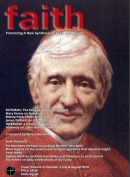Letters to the Editor
FAITH Magazine January-February 2006
Homosexuality
Dear Fr Editor,
Your correspondent D.M. Dell raises homosexual issues in the November-
December Faith. The reality of the Gospel message is that through the ardent pursuit of the Lord, any sexual tendency is emotionally convertible into peace and love beyond understanding. A tendency may remain but as many testify, the conversion is a reality.
Considerations concerning property and money and arranging their transference to same sex friends during life and after death should cause no real problem in the light of this Gospel gem which is far removed from make believe and fairy tale. Yours Faithfully
Bryan Storey …
St Paul the Apostle
Tintagel
Cornwall
Intelligent Design and Cardinal Schönborn
Dear Fr Editor,
I was disappointed to read the dismissive attitude towards Intelligent Design Theory (ID) in the last issue of Faith.
To imply that ID is as flawed and as far away from Catholic teaching as neo-Darwinian evolution is a gross distortion of the truth. Whilst neo-Darwinism seeks to replace God with a wholly materialist and naturalist explanation for life on earth, ID, in stark contrast, is an attempt to demonstrate that God is an essential pre-requisite for life.
ID is indeed “creationist” (and why should a word that clearly implies a Creator be regarded with such evident disdain in the Catholic community, incidentally?), insofar as it seeks to demonstrate that life required a creator. Far from criticising it, we should be recognising it as the most rigorously scientific approach, at least in the biological sciences, to proving the existence of God - and isn’t that, ultimately, what all those who seek to reconcile Catholicism with science are seeking to achieve?
It is certainly far more persuasive than simply pointing out that the natural world appears to have “an “internal finality”, or that it displays “a remarkable unity and finality in its dynamic development”. Frankly, this will not wash with the likes of Richard Dawkins.
If I could now turn to some of the more specific criticisms, it is simply not true to describe ID as a “God of the gaps” philosophy. This is the type of ill-informed labeling that the naturalists in the neo-Darwinian camp indulge in and which Mr. Conway-Morris himself criticised in his article. In pointing out that there are aspects of living organisms for which design is the only rational explanation, ID theory in no sense excludes or precludes the possibility that design was required elsewhere in the organism. The point is that, having demonstrated that design is required to explain at least one part of an organism, whether or not it is present elsewhere becomes wholly irrelevant, because one need only demonstrate that design was required in one aspect to show that a designer mustexist. Nothing is conceded to atheists”.
The fact that some although by no means all) scientists are dismissive of ID is neither here nor there. They are equally dismissive of the Faith synthesis and other theistic evolution theories. In fact, there is a case for saying that the zeal with which ID is attacked by materialist scientists and philosophers is, arguably, evidence of its explanatory force and the threat it poses to the materialist orthodoxy.
Mr. Conway-Morris refers to the many objections” raised against ‘Din the scientific community, but fails to cite a single example. He then attempts to criticise it on theological grounds, describing it as a ‘deist option”, presumably an the grounds that emphasising the machine-like irreducible complexity of organisms at the biochemical level somehow implies the existence of a machine-like creator. I am no theologian but it seems to me that it implies nothing of the sort; indeed, ID theorists have gone to great lengths to point out that evidence of design tells us nothing about the nature of the designer.
Not content with that, be goes on to describe it as a theology that “turns its back on the richness arid beauty of creation”. This is bizarre. In identifying and describing the interconnectedness and interdependence of life at the molecular level, ID has brought out the true majesty of creation.
Finally, I find it odd that Mr. Conway-Morris is quite prepared to recognise the power of the design argument in the realm of physics, in the form of the remarkable fine-wiling and interdependence of the various laws and constants of the cosmos, whilst at the same time being SD dismissive of the biological equivalent.
Together, the Anthropic Principle and ID provide us with not just the keys to a real synthesis of science and religion, but, potentially, two of the most powerful weapons in the battle for people’s minds. Yours Faithfully
Clive Copus
Worple Road
Epsom
Surrey
Editorial
Dear Fr Editor,
Just to thank you for sending me copies of Faith with my Boyle Lecture; I hope it provokes some discussion and I am grateful for your printing it. As you know it will appear also in Science and Christian Belief with three commentaries - Berry, Northcott and Polkinghorne and my response. I was interested in the editorial on Schonborn’s comments. As it happens, I wrote a response for Frankfurte Allegmeine. Yours Faithfully
Simon Conway-Morris
Cambridge University
Dear Father Editor,
Loved the editorial! Yours Faithfully
Roger Peck
Milton Keynes
Pope John Paul II
Dear Fr. Editor,
Lately I have been reading John Cornwell’s biography of the late pontiff entitled The Pope in Winter: The Dark Face of John Paul II’s Papacy” which I found quite interesting but at the same time deeply disturbing. Since the Faith magazine has always been a balanced publication regarding the papacy of the late pontiff, could you offer the readers of your magazine a fair critical analysis of John Cornwell’s book in one of the future issues? I am sure that everybody would benefit from such a thing. Yours Faithfully
Fr. Geoffrey G. Attard
St. Francis
Dundee
Philosophy
Dear Father Editor,
I am a subscriber Faith and intend to remain one!
The latest issue, that reached me this a.m., seems a most interesting number.
Do you know anyone who would be pleased to comment (briefly) for me on the below? I am most anxious to hear about it from someone!
1. Let any body A, at any point P, move away. It can only be at P or distant from P. The two alternatives here exhaust the possibilities: motion from P is not a third possibility: rather must it be seen in the light of the two.
2. Since A can only be at P or distant from P, its “motion” from P is, first, its being at a particular quantity of distance from P. There is a first point reached!
3. A further conclusion can be drawn: when A ceases to be at P, there can be no time between its being at P and its being distant from P. But, we cannot allow this! We must conclude that A is annihilated at P and re-created away from P.
4. We can see in this annihilation and re-creation the answer to the question how does a moving body get beyond any point that it reaches. We cannot say that it moves beyond by way of tracing a line, because motion is not tracing a line, being no more than the moving body’s being at a series of discrete points (Para 2).
5. Regarding any instance of motion there must be a law specifying the quantity of distance from the starting place to the first point reached, otherwise there would be no restriction on the magnitude of this quantity, and restriction there clearly is.
6. Such a law can come only from a mathematical mind (I envisage laws each of which relates to the prior cause of a motion).
7. Einstein’s Special Relativity speaks of “the creation and annihilation of matter”, but I do not know what the elaboration of this amounts to. Sincerely,
Damian Goldie
Church Hill
Totland Bay






